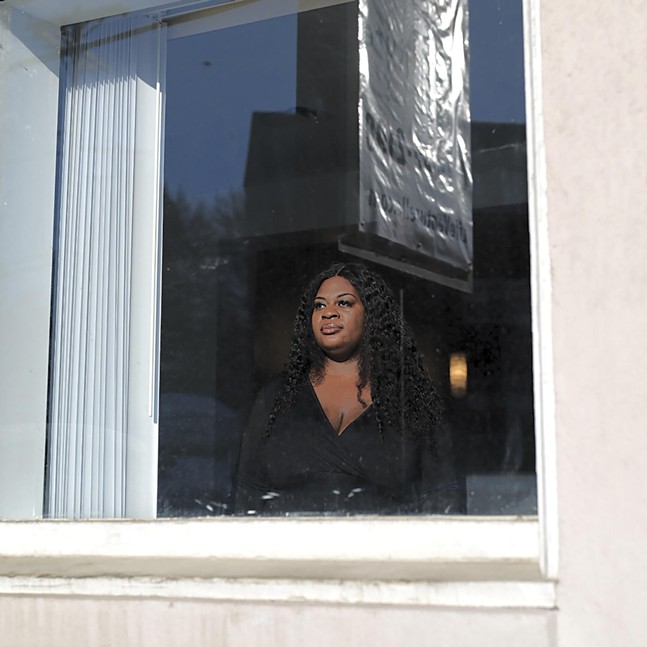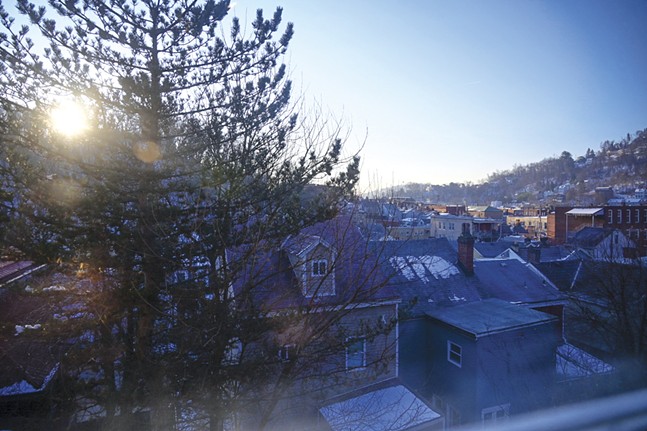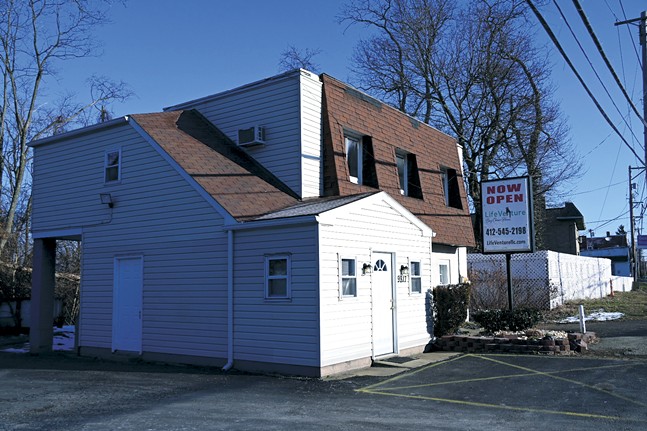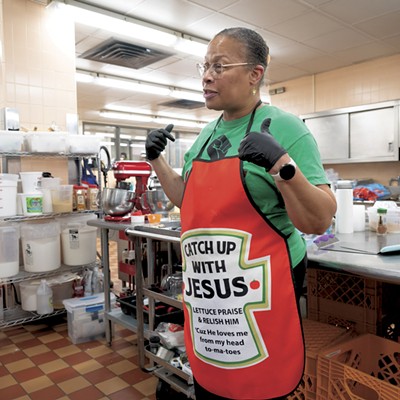“I think that’s what allows me to connect with a lot of my clients, is the fact that I’m also a mom,” Duck tells Pittsburgh City Paper. “And they get it, and they meet my son.”
The director of homeownership for Catapult Greater Pittsburgh and, for about three years, a Realtor, Duck has witnessed and spoken to a lot of local people struggling to buy a house. About 90% of her clients are parents, she estimates — having kids often motivates people to shop for houses. However, there aren't a lot of options for young families or young couples looking to have children. The rising cost of basic necessities and low wages compound the problem, she’s noticed.
“If it’s just one person, you can be a little less selective about what kind of house you get, but if you have four children … there’s not a lot of affordable four-bedrooms in Allegheny County, I’m noticing,” Duck says. “So if you have multiple children, trying to find the space and still stay within your affordability is an issue.”

It’s difficult for millennials to buy a house around the country, especially in cities like Pittsburgh. Ultimately, though, it’s not a generational conflict. Millennials stuck renting and boomers staying in large houses happens because of a system equipped to maximize profit rather than provide people homes that meet their needs.
At the beginning of the month, a New York Times article referenced a January report from the Seattle-based real estate company Redfin analyzing 2022 Census numbers. It featured Pittsburgh in the No. 1 spot of an unflattering top 10 ranking. NYT identified Pittsburgh as the city with the highest percentage of large houses (more than two bedrooms) owned by boomers (those born from 1946 to 1964) without children living at home, at 32%, with 13% owned by millennials (born between 1981 and 1996) with children.
Nationally, empty nest boomers own 28% of large homes compared to 14% by millennials with children, according to the Redfin report. It lists a series of explanations that boil down to some basic facts about the current state of the two generations: Boomers have lived longer, allowing them more time to accrue more wealth and house-hunt; and many millennials can’t afford a house or have lost interest in trying.
The disparity in ownership of large homes between the two generations implies a simple truth — if boomers without kids won’t leave their large houses, it’s only going to make things harder for millennial parents looking to buy those kinds of homes. While the nature of scarcity means there’s some inherent accuracy to this, the full picture is more complicated and, at the root, goes far beyond discussions of age, especially in Pittsburgh, where a disproportionately large number of seniors live.
Making sense of the numbers
When local economist Chris Briem first saw the New York Times article, he initially thought of the lack of incentive for local seniors to sell houses they don’t need anymore. But then he considered what he now says is a potentially more important fact — Allegheny County has a disproportionately large population of those aged 65 and older.
Census figures from 2021 show older residents make up about a fifth of Allegheny County, second only in percentage to boomer haven Palm Beach County, Fla. in a ranking of the country’s 40 largest counties, according to a 2022 University Center for Social and Urban Research report co-authored by Briem. This flows from the economic history of the region — when the steel industry collapsed, young people left and started families elsewhere, he says.
This doesn’t mean that the percentage of houses owned by empty-nester boomers compared to millennial parents isn’t relevant, according to Briem, but it doesn’t necessarily make the case that it’s harder for a millennial to buy a house in Pittsburgh compared to other places.
“There’s a lot of issues that we’re studying right now that have to do with national real-estate investors buying up these middle-value homes that I think are really displacing [people],” Briem tells City Paper. “So, if there’s a challenge right now in terms of someone going out and trying to buy their first home, it’s not this.”
Jackie Smith, a University of Pittsburgh sociologist whose research primarily focuses on housing, blames the difficult market on a global treatment of housing as a commodity — a product to be sold for profit, in other words. Echoing and fleshing out one of the explanations offered by the NYT article, she says boomers wouldn’t be able to afford houses on today’s market, either. While seniors are typically wealthier, they often have astronomical healthcare costs, she notes.
“It’s not really helpful to frame this as a conflict between generations because it’s really a much more complicated scenario, and, also, within generations, there’s a lot of variation in people’s situations,” Smith tells CP. “I think it’s more about class than age.”
In addition to her work in academia, Smith is involved in community organizing around human rights, which has helped her learn that housing ends up being the most pressing need for many people, she says.
“If we look at who's buying up both rental properties and homes for sale, it’s these private equity firms that are really just looking to make profits and sometimes just park their money in an asset that is pretty guaranteed,” Smith says. “And they don’t even care if there’s anybody in the unit. In fact, they don’t like tenants, because tenants want things fixed and require a little more management.”
Pittsburgh’s high student population relates to particular challenges in the region. Smith says the University of Pittsburgh, her employer, brings a lot of people needing a place to live without a proportional amount of student housing. And the housing market doesn’t fill those gaps.
“A lot of the new building in Oakland are these real-estate investment trusts building luxury student housing,” Smith says. “All those new high-rises, those are student luxury housing, not student affordable housing.”
Navigating a difficult market
Duck learned she’d be a mother shortly after becoming a Realtor. Even though the now-35-year-old spent much of her time figuring out how to buy affordable houses, she didn’t immediately start to house-hunt for herself. She eventually decided on a three-bedroom house in Munhall. Factors concerning her son’s well-being ranked highly in her decision-making — she wanted to be close to loved ones who help her care for her son, for example.
“I think I had been so focused on helping everybody else that I didn’t even think about, ‘when is it gonna be my time?’” Duck says.
Just when Ben Banyas, another millennial who recently became a homeowner, was planning to leave Pittsburgh, he started dating a woman he now lives with in Millvale. He heard talk of promising money-making opportunities in Seattle and almost left the region he’s lived in since growing up in Castle Shannon, but now he owns a house in the area.
When Banyas, an Uber driver, and his partner, a teacher, began shopping for houses, they had a budget in the ballpark of $130,000. Their search began in Bloomfield, which appealed to them as a central location to work and friends, but that proved fruitless. The most promising houses revealed to them some of the darkest aspects of the local housing market.
“There were a couple places that we looked in Bloomfield that we maybe would have been interested in, but they clearly had long-term renters in, and it was clear that the owner basically was just going to wait until they got a buyer to kick them out,” Banyas, now 39, tells CP. “And we did not feel comfortable doing that.”

After a long house search that sent them in and around the city, they bought a two-bedroom Millvale house for about $138,000. They’re satisfied for now but unsure about how long they’ll stay in the house, he says.
“I honestly don’t know,” Banyas says. “Sometimes, we are like, less than five years, but then sometimes we’re like, it could be 20 years. It could be our whole lives.”
The two have considered adopting or fostering children but not until years down the line — as he sees it, they’re in the midst of career changes, especially for himself. He makes less and less each year as an Uber driver and hopes to break out into nonprofit fundraising, a field in which he’s already dabbled.
When discussing the larger issue of affordable housing in the Pittsburgh area, Banyas becomes distraught. He references Lawrenceville residents pushed out during the 2008 financial crisis and the loss of affordable housing in East Liberty. He’s had difficulties, and many others have had difficulties — some especially dire.
“It just sucks, man,” he says.



















